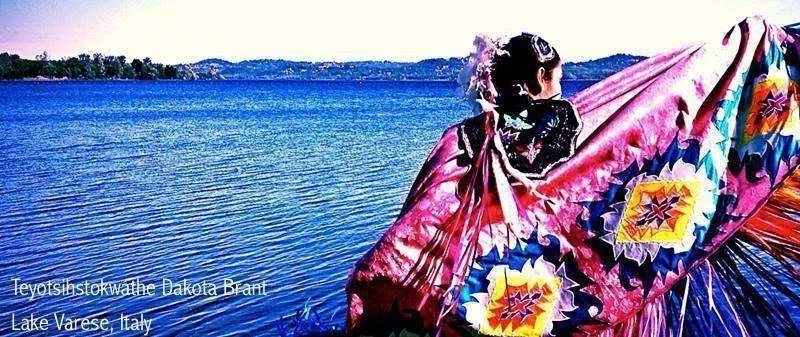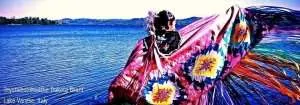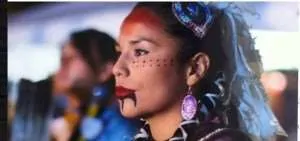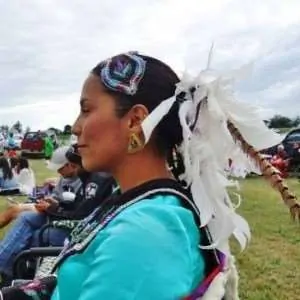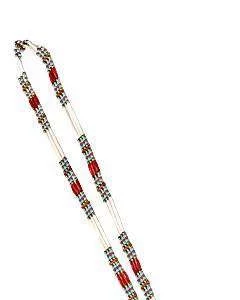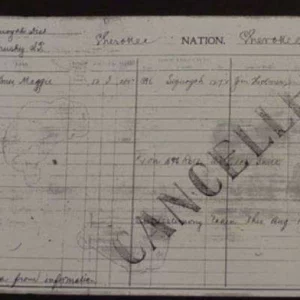Interview by Dr. Dawn Karima, PhD, Native American Culture Editor
Q) It's great to visit with you!!! What are some of the traits you like best about YOU?
A) I’m a twin, an auntie, a daughter and purebred gardener. I’m proud to say I will be completing my Master’s in Indigenous Community Planning from the University of British Columbia this spring!
Q) Congratulations! How delightful! We are all uplifted when any of us completes a degree! I know you value academics, but what are some of your tribal values that shape your character? How so?
A) I’m Mohawk turtle clan from Six Nations Territory. I think our Haudenosaunee (Iroquois) people are extremely resilient, so many world class native entrepreneurs, artists, and athletes come right from my home community and territory like Graham Green, Derek Miller, Gary Farmer, Santee Smith, Jay Silverheels, members of a Tribe Called Red, my list can go on! When we know who we are, finding our strength isn’t so hard.
For me, my family strength was farming. Since time immemorial we have been farmers. My family even carries Tobacco seeds that we brought with us to Six Nations from the Mohawk Valley after the American Revolution; who knows how long we had those seeds before that! Being able to rely on myself to grow my family’s food has been a source of pride; gardening isn’t easy or always fun. But being able to rely on the fact that food is always there allows for us to grow in other areas. Our cultures across Indian Country would be nothing if we did not first take care of our food sources.
Q) As you talk about sources of strength, what does dancing mean to you? How would you describe the meaning of dances to someone who had never been to one? Why should they attend?
A) The meaning of dancing can change from ceremony to ceremony. Each dance has a context, a story and a responsibility attached to it however I 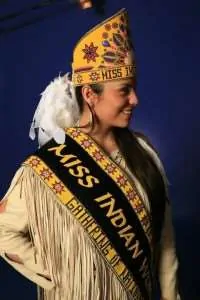
We are constantly working on ourselves outside of the dancing circle. We exercise, we eat right, we ceremony, we avoid mind-changers. It takes a lot of discipline, nobody is perfect at it, but it really shows in the arena who is disciplined. I think ceremonial dancing and public dancing are different in their purposes, but they still require dancers to educate themselves of the history of the dances they share. A true champion is constantly working on all of these things, and knows full well there is no end to self-improvement.
Q) You are always so lovely! I have fond memories of your time as Miss Indian World and we all enjoy seeing you in regalia!
A) I feel electric! Like I can do anything! I am also incredibly aware of the suffering my ancestors went through so that I might exercise the right to wear our clothing. When I dance I am free. So often I am sad, alone, angry, stressed and when I am dancing for a few minutes I am able to let everything go and just exist in my own body free of the things that make my life hard. When you see me dance, you see me. It’s hard to be completely you all the time! I think that is a gift dancers give to the public; just being able to see us for who we are for a few minutes. Real human beings.
Q)What are some of the lessons from your Tribal heritage that keep you spiritually centered? How do those internal ideas influence your dancing?
A) I am wickedly stubborn. I have no shame in admitting this! I get angry, frustrated, and hold on to negative energy longer than I should. My people are the carriers of the Kayanere’kó:wa, known as the Great Law of Peace, the Great Path, or the Great Goodness. The core principles of the Kayanere’kó:wa are to live with Skén:nen (peace), kahsahsténhsera (power, or strength) and ka’nikonhrí:yo (a good mind, or righteousness). Don’t these things sound confrontational to you? How can you be powerful when you have to have peace? How can you be righteous when there are so many people in this world who abuse their power? Our great task as humans is to live in equilibrium with these three principles.
How can I be at peace? It means I have to think about how I use my power and that requires using a good mind. My power can mean my physical strength, or my spiritual. I have the capacity to use both of them to abuse another person. Our Creation story tells
us that humanity is given the choice to do both. These principles need to become physical manifestations in my life to allow me the honour of walking the Great Path, the Kayanere’kó:wa.
Dancing has become a positive outlet for me to allow these principles to manifest themselves into my life physically. I can’t promise I will always walk that path, but I do seek solace in knowing that the dance arena is a place where I can be free.
Q) Such evocative words! No wonder your dancing seems so powerful! Peace is a wonderful state to seek. Have you always danced?
A) I guess I have always danced, although I did not dance powwow until I was about 17. At home in Haudenosaunee Territory we have a dynamic culture of social and ceremonial dancers unique to our people. Smoke Dance is our competition dance. I have social danced my whole life but didn’t enter a Smoke Dance competition until I was 17, the same as with powwow for me. I was always drawn to Fancy Shawl dancing.
When I served as Miss Indian World, a lot of people assumed I have been a powwow dancer my whole life, but in actuality I do not come from a family of dancers. I do come from a family that has always been encouraging of my interests and talents. My sisters often help me design, bead and sew my regalia, and are often called upon to help with regalia for others as well. They are gifted that way. My mom has always been encouraging and reminding me that these dances come with purpose and it is important I take the time to learn them. My dad, he is the type
to stand back and watch, but he is almost always sure to take the time to watch me in competition. He has always been there to watch, from when I was strapping on my tap dance shoes as a 5 year old to today.
Q) Since your tribal dance styles were passed on to you, it sounds like you had to make the decision yourself to pursue powwow dancing? How did you select your category?
A) The Fancy Shawl dance has always stood out to me, even as a child, because of its combination of athleticism and grace. Smoke Dance awakens the same spirit in me as well. Fancy Shawl dance, looking across its history, came to represent the young woman’s right to question everything about our culture. Fancy Shawl dance, while a fairly new dance, is steeped in protocol and tradition for which I think it took hold so strongly in Indian Country, given it seemed like a pretty extreme change of protocol in the dance arena during that generation it initially gained fruition.
In my mind’s eye as a kid, Fancy Shawl dancers were the spirit of young female grace and strength made physical. I don’t think this thought has really changed for me. I love nothing more than seeing a dancer test her own limits, wear a smile, and make physical a genuine appreciation for her dance style and the people who came to watch her.
Q)Have you personalized your dance style? How so?
A) You can tell I’m a Smoke Dancer!! Haha you’ll have to know Smoke Dancing and watch me dance to get that one!
Q)Haha! Yes, you are definitely a Smoke Dancer and it's a pleasure to see how you intertwine your Smoke Dance skills with your Fancy Shawl footwork! And you look so pretty in your regalia!
A) Well, I have two types of regalia; my Fancy Shawl regalia and my Smoke Dance regalia. I wear the contemporary style raised Haudenosaunee beadwork for both regalia, I made pieces that go specifically to each outfit, but I interchange my collar, armbands, hair ties, my plumes. This is just my regalia now, my style is always evolving. I am working on a new fancy shawl beadwork at this moment.
I don’t stay attached to certain colors, but I do tend to put together colors that do not look like they will match, or are necessarily popular colors, but I thing they seem to work brilliantly when the pieces just come together. I tend to design my beadwork on the fly, if I spend too much time designing or thinking about it then they designs don’t seem to come out right or look too controlled. I must have went through a dozen drawings of my current beadwork, until finally I just threw the designs out, took a pencil, and just drew a design on the fly. It worked.
I love my designs, and they came out more sentimental then the designs I was wracking my brain over. I wear hummingbirds in my beadwork, I am putting them into my new beadwork as well. They are my mothers favorite bird, and I wear two to represent her and my grandmother, my maternal lineage.
Q) What do you think folks will learn about themselves as they attend dances? What do you hope that they will discover about Native People and Culture?
A) Hard work will take you far; but listening will take you places you never even dreamed of. This was a huge lesson for me when I served as Miss Indian World. Regardless of where I visited in Indian Country, people wanted to share with me and I know my most valuable experience came from taking the time to listen to someone in-depth and with a profoundly non-judgmental ear.
It doesn’t take a lot for a culturally poor person to share what they have; ironically it is a culturally rich person who in my experience tends to be harder to share with. I guess its because the rich people know how hard it was to maintain what they have, and are willing to defend it. That being said; it was a better learning experience for me to sit, have a tea and meal, and listen then to shake a hand and expect an opening of the soul.
It is my hope that people who do not know a lot about our cultures can understand that a simple and seemingly unrelated conversation is very much a
part of the protocol of understanding who we are, and how to get us to share. This is something that takes personal practice, patience, and is every bit about self-discovery as it is cultural discovery.
Q) I appreciate your eloquence in putting the power of a good powwow into words. Aside from good feelings, what makes a good powwwow?
A) Any powwow that involves Ruben Little Head or Dennis Bowen as MC!! Those guys are hilarious! Haha…but seriously, the best events where we share our culture are the ones where the air is thick with laughter, light heartedness, and all the cute little Indian babies are allowed to run around and scream and be kids. When kids are allowed to play and learn through play, you know the spirit is good and a thousand good lessons are being learned.
Q)Agreed! I am so pleased that Powwow Season is underway! And I'm grateful you could visit with us today! What else is on your heart to share?
A) I worked really hard for every lesson I have. I shed a lot of tears for them and still I continue to struggle. I have lived a blessed life, but it did not come from the stars aligning a certain way, it came from working hard. Some lessons came easy to me, just as they do for others but some lessons are still bumping me in the head trying to get in there!
I have more bad days then I care to admit but they make me human. Losing is not the end of the world, it is not the Creator saying no. It is the Creator simply saying not right now. Go along in a good way as best as you can and continue to breathe energy into your life, no one can do this for you.
Dr. Dawn Karima (Creek/Cherokee) is the author of two novels about Native America, THE WAY WE MAKE SENSE and THE MARRIAGE OF SAINTS.
